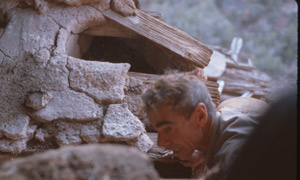Finding Adobe from the Back of the Bus
Edward Crocker
My mother came to northern New Mexico in 1944 while my dad was in
Belgium fighting the Battle of the Bulge. She had been raised in
southeastern Kansas by strict Pennsylvania-Dutch parents and had
decided that she wanted to raise her family elsewhere. When dad got
back to Fredonia on furlough he found a note on the door that
essentially said "Hate Kansas, took the kid to New Mexico."
Dad hopped the Greyhound to Santa Fe and from there caught the Chama
Valley Line to Abiquiu. He got off at Highway 68 and hitchhiked the
final twelve miles to El Rito where mom had a job and was living in a
little adobe house with my two-year-old sister. My father was a dark,
wiry man with curly black hair. It wasn't until decades later when he
was telling the story of his coming to New Mexico that we all realized
that when the driver of the northbound coach had asked him to go to
the back of the bus, it was not a logistical request.
Dad took mom and my sister back to Kansas when his furlough ended and
returned for his final tour of duty in Europe. When he was discharged
and came home he found a note similar to the first, only this time mom
was determined; he had to choose. He chose wisely and together they
made Santa Fe a wonderful home for my sister and me.
In those post-war years we, like many families, built a house, got a
telephone, went to school, did our chores, played board games, and
exuded pride in the first new car we ever owned, an Edsel. And in the
fall, dad and I went hunting.
My father raised me to be a hunter but I had my fill of the blood part
of the sport after killing one deer and one elk by the time I was
thirteen. I still went hunting because I loved the connection with
dad and his crusty old friends. It was great to walk around with a
loaded rifle, miss every shot, eat pork 'n beans cold out of a can,
freeze on one side and roast on the other in front of the gigantic
campfires we built and, invariably, have to dig the truck out the mud.
 The best hunt we ever had was just north of Abiquiu where the Gallina
River enters the Chama. Dad had hunted the area frequently and on an
early occasion had discovered some cliff dwellings in an inaccessible
portion of the vertical, red Chinle Formation. He told no one and
waited to go back until I was old enough to make an expedition of it.
The best hunt we ever had was just north of Abiquiu where the Gallina
River enters the Chama. Dad had hunted the area frequently and on an
early occasion had discovered some cliff dwellings in an inaccessible
portion of the vertical, red Chinle Formation. He told no one and
waited to go back until I was old enough to make an expedition of it.
We hauled hundreds of feet of old manila rope across the Chama and
after the fording dad took out his old army binoculars and showed me
our destination. "See that promontory about a mile up the canyon?
Follow it north about two-thirds of the way to the end of the red
wall. Now, imagine that you just caught me from behind with my pants
down."
There it was, perfectly described, and just inside the right thigh was
a little cave in which I could make out several earthen buildings.
Later that day we had climbed up to the Bushy Basin member of the
Morrison Formation, well above the cleft, and tossed our ropes over.
Going back down we were able to scramble into a little shelter with
four small buildings in it. Unforgettable.
I had already fallen in love with mud, in large part because of an
earthen roof with cactus growing out it we once had on Agua Fria
Street. On a fall day that began by tracing dad's first route into
northern New Mexico in the back of a bus, that relationship became a
lifelong affair.

